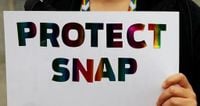Millions of Americans who depend on the Supplemental Nutrition Assistance Program (SNAP) are facing an unprecedented crisis as the federal government shutdown continues to disrupt the flow of food assistance. With around 42 million people across the United States relying on SNAP to put food on the table each month, the uncertainty triggered by recent political decisions has left families, food banks, and local governments scrambling to fill the gap.
The trouble began in earnest on November 2, 2025, when President Donald Trump announced that he would withhold all SNAP payments until the government reopened, despite two federal judges ruling that such a freeze was unlawful. According to Axios, the administration’s move came as food costs were already rising, and the abrupt halt to benefits forced low-income families into painful choices—deciding whether to pay rent, buy food, or even skip meals so their children could eat.
While the White House reversed course on November 4, announcing it would fund half of the $8 billion needed for November’s SNAP payments, the situation remains murky. The United States Department of Agriculture (USDA) said it could take “several months” for the partial benefits to reach recipients, as states scramble to update their systems. In a court filing, the USDA stated it had complied with the October 31 federal court order by tapping into its contingency fund for the first time during a funding lapse—funds typically reserved for natural disasters like hurricanes. However, because the contingency fund was insufficient for full benefits, November’s SNAP payments are being cut by half, with a single person in the continental U.S. and D.C. receiving a maximum of $149.
In a statement to Business Insider, the USDA explained that it chose not to divert billions from Child Nutrition Programs to avoid a shortfall in school meal funding. The agency said, “The result would be a substantial shortfall in funding school meals, among other things, that would likely not be filled by any future appropriation.”
President Trump, for his part, was blunt in a November 4 post on Truth Social: “SNAP BENEFITS, which increased by Billions and Billions of Dollars (MANY FOLD!) during Crooked Joe Biden’s disastrous term in office... will be given only when the Radical Left Democrats open up government, which they can easily do, and not before!” Despite this rhetoric, the White House later clarified that partial payments would go out, though the timeline remains unclear.
The impact on everyday Americans has been swift and severe. As Axios reported, calls to the Capital Area Food Bank’s hunger hotline tripled in the week leading up to November 5. Radha Muthiah, CEO of the Capital Area Food Bank, said that food distribution targets had to be increased by 20% this year to meet the surging demand. “Family and friends are stepping in,” she said, but even they are feeling the strain. Grace Robinson, a disabled woman in Pennsylvania, relies on her parents to help make up for her lost $100 a month in SNAP benefits, but they’re already stretched thin.
Local organizations and charity programs have stepped up to try and bridge the gap. Project Angel Food, a nonprofit meal provider in Los Angeles, began delivering $100 grocery gift cards to its clients who rely on SNAP. “We know there’s about 3,000 people a day who rely on us for medically-tailored meals. Of those 3,000, about 25% also get SNAP to get some additional groceries. At Project Angel Food, we’re going to take care of those 650 people,” CEO Richard Ayoub told the Beverly Press. He added, “We are making sure that our clients have a little bit of a buffer.”
U.S. Rep. Laura Friedman (D-Glendale) joined Project Angel Food on October 31 to highlight the crisis. She said, “There is no excuse for the Trump administration to defy a court order and deny food assistance to millions of Americans. SNAP shouldn’t be a political bargaining chip, it’s how many families in my district survive.” Friedman vowed to keep working to bring Congressional Republicans to the negotiating table, stressing the urgency of ending the shutdown and protecting affordable healthcare.
Other organizations are feeling the strain as well. Meals on Wheels West, which serves coastal communities in Los Angeles County, is seeing more neighbors reach out for help. Executive Director Kaylee Hawkins told the Beverly Press, “As SNAP benefits remain uncertain, we’re already feeling the impact here at Meals on Wheels West – with more neighbors reaching out for help. Our team is doing everything we can to meet the growing demand, but limited resources are beginning to stretch our capacity. The need is real, and it’s growing.”
U.S. Rep. Ted Lieu (D-Torrance) visited Meals on Wheels West on November 3 to discuss the impact of federal funding cuts. “Programs like Meals on Wheels provide nutritious meals and support to homebound, disabled and elderly people in our community and around the country. Meals on Wheels relies on the kind of federal funding that the Trump administration and Congressional Republicans cut to fund billionaire tax breaks and Trump’s pet projects. To compound the suffering, Trump has refused to use all the money available to fund SNAP this month, stretching programs like Meals on Wheels even thinner as they try to help hungry community members. It’s simply immoral,” Lieu said.
Food banks across the country are also ringing alarm bells. Genevieve Riutort, President and CEO of Westside Food Bank, which provides food for 72,000 households in western L.A. County, said, “We are deeply concerned that our current resources are insufficient to meet this looming crisis. We do not have extra food stockpiled, as we had already been clearing the shelves to meet the recent rise in food insecurity. We need donations, and we need them now.”
State and local governments are taking action as well. California Governor Gavin Newsom deployed the California National Guard to support food banks and announced $80 million in state funding for food aid on October 22. Los Angeles Mayor Karen Bass mobilized the city’s FamilySource Centers and allocated funds for grocery cards to help families in need, stating, “No one in Los Angeles should have to worry about putting food on the table because of circumstances beyond their control. We are mobilizing every resource available to help our communities.”
Meanwhile, the White House has defended its actions, with spokeswoman Anna Kelly telling Axios, “The administration has been uplifting families by lowering costs and creating jobs while simultaneously eliminating waste, fraud and abuse across many programs.” Press secretary Karoline Leavitt added, “Grocery prices are coming down, such as egg prices – which have plummeted by nearly 80% – and we recognize there is more work to be done.” Still, many experts and advocates say these claims ring hollow for families facing empty refrigerators and long lines at food banks.
With the end of pandemic-era supports and the discontinuation of the annual Food Insecurity Report, it’s becoming harder to track just how deeply the crisis is cutting. For now, the stories of everyday Americans—forced to choose between paying for food, rent, or medicine—paint a stark picture of a nation grappling with hunger amid political gridlock and economic uncertainty.






